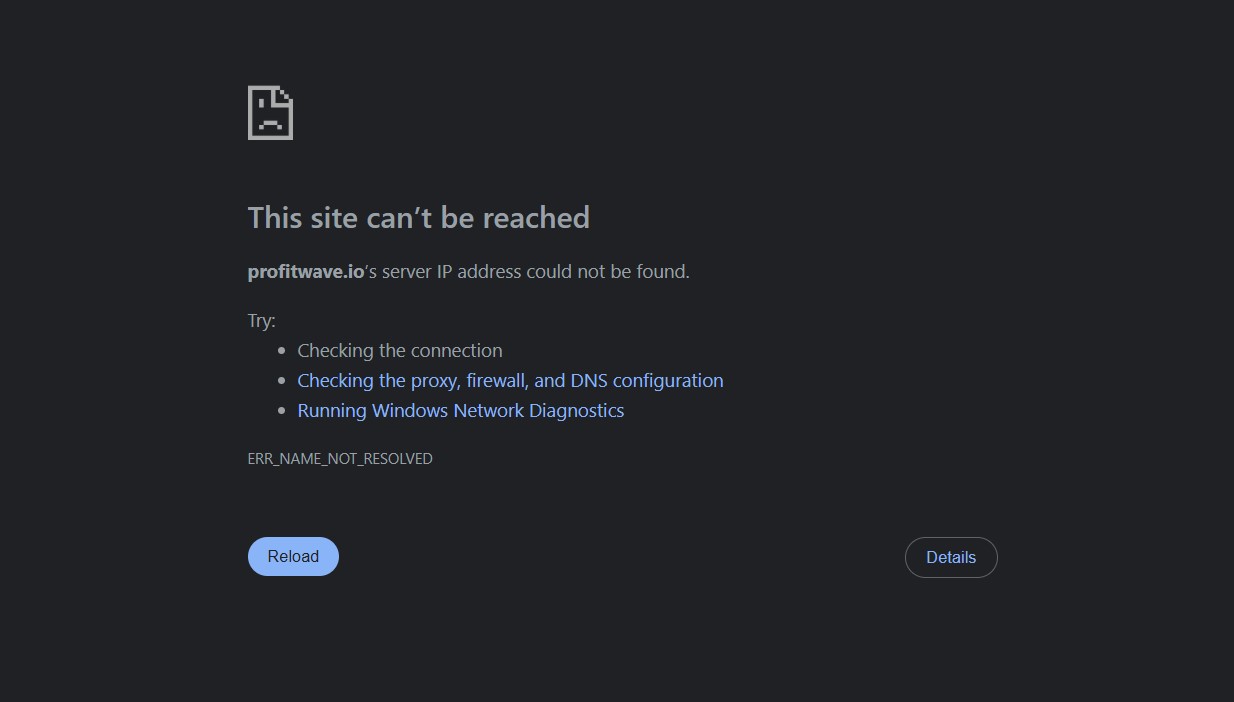ProfitWave.io Scam Review -A Deceptive Scheme
Opening — the demo that felt too neat (investor vignette)
Sophie saw a polished ad: “ProfitWave.io — automated AI trading, 8–12% monthly returns.” The landing page showed a tidy dashboard, a smiling “head trader,” and a chat pop-up offering a free account review. Sophie made a small test deposit to see how the platform performed. At first everything looked great: the account balance ticked up, the rep was friendly, and a small withdrawal went through without issue. Encouraged, Sophie added more funds.
A week later, when she tried to withdraw a larger amount, complications began. Suddenly there were new verification steps, a “processing fee” she hadn’t been told about, and requests to upgrade her account before the funds could be released. Her account manager became harder to reach. That narrative — easy onboarding, early small wins, then friction at payout time — is the recurring pattern that colors the ProfitWave.io profile and prompted this closer look.
Short verdict (risk-based)
ProfitWave.io exhibits multiple practical warning signs: limited public disclosure about the company and team, absence of clearly verifiable regulation, aggressive marketing and upsell mechanics, and repeated operational patterns where withdrawals become difficult after deposits increase. Taken together, these indicators form a pattern consistent with high-risk platforms. This is a risk-based assessment, not a legal judgment.
1) Polished presentation, thin verifiable facts
The website invests heavily in professional design: glossy UI, performance charts, testimonials, and a claims page about “proprietary algorithms.” That presentation creates immediate trust — which is the point.
What credible platforms pair with that polish are clear, independently verifiable facts: a legal company name and registration number, a physical office address, named executives with traceable professional histories, and transparent custodian relationships for client funds. ProfitWave.io provides marketing copy but lacks robust, checkable disclosures. Where company registration, licencing, or custody information should appear, content is vague or absent. That gap turns design into persuasion rather than proof.
2) Ownership and accountability — who can you hold responsible?
A basic due-diligence question is simple: who is behind the platform? Reputable firms make this obvious; risky ones often obscure it. Red flags in this area include:
-
A privacy-masked domain registration (WHOIS privacy).
-
Generic “about us” bios with stock images rather than real credentials.
-
Contact addresses that point to virtual office providers or PO boxes.
When operators hide ownership or use privacy proxies, accountability evaporates. If funds become stuck or disputes arise, anonymous operators are much harder to pursue. ProfitWave.io’s public footprint contains several of these obfuscation traits.
3) Regulation — the single most important external protection
Licensing by a recognised financial authority is a primary consumer protection: it enforces safeguards like client money segregation, audits, minimum capital and complaints handlers. Legitimate trading platforms display licence numbers and regulator names so you can confirm them independently.
ProfitWave.io does not present clear, checkable licences from established regulators. Vague statements about “working with regulated partners” are not the same as being regulated yourself. Without visible, verifiable oversight, customers have fewer protections if things go wrong.
4) The onboarding funnel — warmth that accelerates deposits
Platforms with problematic behaviour tend to follow a predictable funnel:
-
Fast, frictionless signup and human outreach.
-
Small early wins or a demo to build trust.
-
Persistent nudging to upgrade to higher tiers with larger minimums.
-
New hurdles when users try to withdraw significant sums.
ProfitWave.io’s flow mirrors this sequence: immediate contact from an “account specialist,” VIP tiers promising better performance for larger deposits, and promotional pressure to “lock in” bonuses. That sequence is effective at converting cautious curiosity into escalating financial exposure before proper verification takes place.
5) Deposit vs withdrawal asymmetry — the operational litmus test
One of the clearest pragmatic checks is how the platform treats money going in versus money coming out:
-
Deposits are typically processed quickly and through multiple channels.
-
Platforms that are risky often allow small test withdrawals to build confidence.
-
Larger withdrawal attempts then trigger extra verification steps, surprise fees, or indefinite delays.
If you see “easy in, hard out” behaviour — and multiple reports indicate ProfitWave.io follows that pattern — treat it as a very strong warning sign. It’s the most consistent operational red flag across many problematic platforms.
6) Testimonials, dashboards and “on-site proof” — persuasive, not audited
ProfitWave.io shows screenshots, client quotes, and bold performance numbers. Those are powerful conversion assets, but they’re internal and easily curated. Real verification would include:
-
Exportable transaction logs reconcilable to bank or exchange statements.
-
Named custodians or banks holding client funds.
-
Third-party audit attestation or proof of segregated accounts.
Absent these verifiable anchors, on-site proofs remain marketing collateral rather than independent evidence.
7) Contracts and small print — where the practical levers live
Terms and conditions contain the real mechanisms platforms use when matters get contentious. Clauses to watch for include:
-
Broad rights to freeze or withhold funds for vague “security” reasons.
-
Processing or “release” fees that appear at withdrawal time and weren’t disclosed earlier.
-
Bonus rules that tie funds to unrealistic trading volumes, making principal non-withdrawable.
-
Dispute resolution clauses that force arbitration in distant, hard-to-use jurisdictions.
If ProfitWave.io’s terms include such levers, those are the tools likely to be invoked when withdrawal disputes arise.
8) Technical footprint & rebrand risk
Short domain age, masked WHOIS, and hosting patterns that mirror other suspicious sites are all technical cues to watch. They don’t prove malice — legitimate startups can be new — but they make it easy for operators to rebrand or vanish. ProfitWave.io contains a combination of these technical signals, which increases practical fragility: if scrutiny rises, it’s easier for a poorly documented operator to pivot or disappear.
9) Psychological mechanics — why smart people get pulled in
ProfitWave.io’s mix of polished UX, friendly reps, and early small wins leverages behavioral biases: FOMO, authority cues (AI, institutional language), and the endowment effect once small profits appear. These levers shorten deliberation and make escalating deposits emotionally easier. Recognising those mechanics helps explain how otherwise careful investors can make rapid risky choices.
10) Quick red-flag checklist — a one-page test
Use this checklist before risking capital with ProfitWave.io:
-
Is the legal company name and registration number published and verifiable?
-
Can you confirm a licence with a recognised financial regulator?
-
Are custodial banks or third-party auditors named and checkable?
-
Do performance claims include exportable trade logs or third-party audits?
-
Are withdrawals processed reliably at scale, not only tiny tests?
-
Do account managers pressure you to deposit more before you test withdrawals?
-
Is the domain recent and ownership masked?
-
Are testimonials corroborated independently outside the platform?
If multiple answers are “no,” the platform’s risk is materially elevated.
Conclusion — why the pattern matters
No single concern equates to proof of criminal intent. New companies exist, and sometimes legitimate services are poorly documented. The practical danger comes when several concerns accumulate: masked ownership, absent regulation, persuasive marketing that accelerates deposits, curated internal proofs rather than auditability, and deposit-easy/withdrawal-hard stories. ProfitWave.io currently displays multiple elements of that risky constellation.
This review is a risk-based assessment, aimed at giving clear, testable signals readers can use to protect capital. Until ProfitWave.io publishes transparent company registration, verifiable licences, named custodians, and independent audit evidence — and demonstrates a consistent history of reliable, documented withdrawals — it should be approached as high-risk.
Report ProfitWave.io Scam and Recover Your Funds
If you have lost money to ProfitWave.io Scam, it’s important to take action immediately. Report the scam to Jayen-consulting.com, a trusted platform that assists victims in recovering their stolen funds. The sooner you act, the better your chances of reclaiming your money and holding these fraudsters accountable.
Scam brokers like ProfitWave.io continue to target unsuspecting investors. Stay informed, avoid unregulated platforms, and report scams to protect yourself and others from financial fraud.
Stay smart. Stay safe.






